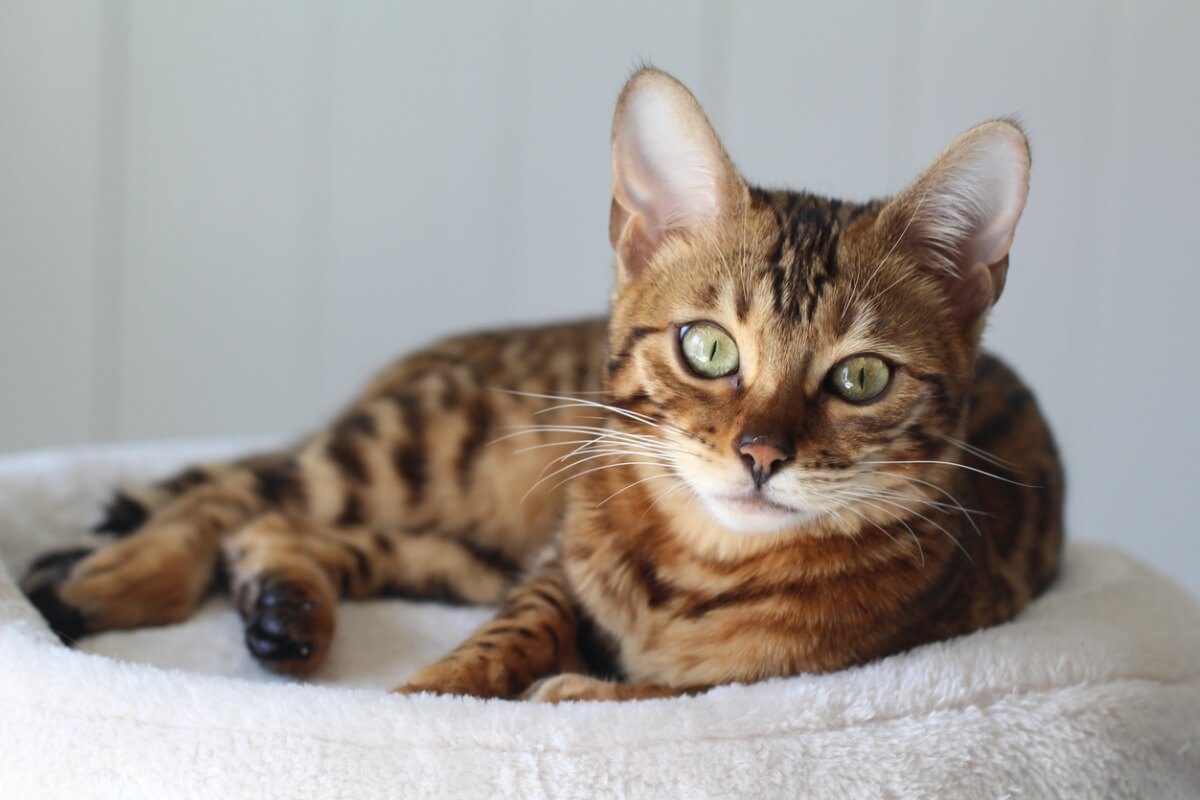How to Prevent and Eliminate Fleas in Cats


Written and verified by the psychologist Sara González Juárez
Fleas in cats are one of the owners’ most feared problems, especially by those who look after cat colonies, or whose cat goes into the street. These external parasites, in addition to causing intense itching, are also capable of transmitting diseases such as bartonellosis.
What can you do then, when faced with this threat to your cat’s health? Both preventing them and knowing how to eliminate them is crucial, so don’t stop go away! We’ve got some great advice for you!
How to prevent fleas in cats?

Prevention should be your first strategy. It will always be simpler, easier, and cheaper to prevent fleas from getting on your feline than having to deal with an infestation. Let’s take a look at the most common methods.
Flea collars
Flea collars are a good idea for maintaining long-term protection, as they release the dewormer gradually and in small doses. In addition, many of them contain natural essences that also act as repellents.
Make sure you buy a good quality one and change it when necessary (they usually offer protection for about 3 months, on average). Many of them protect against several types of parasites, not only fleas, so you’ll add an extra effect against, among others, ticks and mosquitoes.
It’s not only fleas that transmit diseases; ticks can also carry feline cytauxzoonosis or Lyme disease.
Pipettes
Some cats don’t put up with flea collars and they could pose a danger to them when they wriggle into tight areas where they can get stuck. In these cases, pipettes are the best option. This is a liquid containing antiparasitic substances that must be applied directly to the cat’s skin, pushing the hair aside.
The effect of pipettes isn’t as long-lasting as that of collars, but it’s a periodic and timely deworming. Therefore, it’s usually necessary to apply them every month, or even less (depending on what the veterinarian recommends).
Flea sprays for cats
Some cats aren’t too keen on pipettes either, especially when these have an unpleasant odor for them or the handling is stressful for them. For these cases, there’s a simpler method: sprays. It consists, simply, in spraying the cat with the medication, taking care that it doesn’t get into the eyes or nostrils.
However, the effect is slower, as it isn’t applied to the cat’s skin. Therefore, results won’t be seen for a day or two and the risk of dermatophytosis and other associated ailments will increase.
They shouldn’t be used when there’s an imminent risk of infestation by external parasites, but they are useful to reinforce other methods, such as flea collars.
How to eliminate fleas in cats
No matter how much prevention you apply, accidents do happen. While this isn’t a reason to continue using the methods mentioned above, it will be necessary to know what techniques can be used to eliminate fleas on cats in cases of infestation. Let’s take a look at the most effective ones.
Anti-flea shampoos
Although it isn’t advisable to bathe cats, in this case, it will be your best asset against fleas. A thorough bath with a shampoo specialized in eliminating external parasites in cats will ensure that fleas don’t stay in their fur.
Felines aren’t able to eliminate fleas only with grooming, as they bury themselves in the fur and move very fast.
Subsequent preventive treatment
Once your cat is dry and free of fleas, apply a preventive treatment to complete the treatment. Flea collars, pipettes and sprays are all valid options, so choose the one your cat tolerates best.
Without this step, flea infestation is very likely to reoccur. Prevention is the difference between dealing with a one-time event and dealing with a recurring problem that deteriorates your cat’s health.
Home treatment
While it’s unlikely that your home will suffer an infestation if it’s a small infestation, it never hurts to make sure they don’t stay in the home. These parasites can survive and proliferate in materials such as carpets and upholstery, so you should vacuum thoroughly for several days.
After each use, throw away the vacuum cleaner bag so that adults and possible flea larvae cannot get out. Washing all textiles in the house at 60ºC will also help, as well as scrubbing the floor and surfaces with specific products.
The importance of the vet to control fleas in cats

Each antiparasitic, and even each brand, has its own specifications. In addition, the age of the cat influences which one you should apply. Therefore, in addition to your own preventive work, don’t forget to comply with the schedule of vaccinations, check-ups, and deworming that your veterinarian prescribes. Fleas can be a real nuisance, but all problems are best solved with the help of a professional.
Fleas in cats are one of the owners’ most feared problems, especially by those who look after cat colonies, or whose cat goes into the street. These external parasites, in addition to causing intense itching, are also capable of transmitting diseases such as bartonellosis.
What can you do then, when faced with this threat to your cat’s health? Both preventing them and knowing how to eliminate them is crucial, so don’t stop go away! We’ve got some great advice for you!
How to prevent fleas in cats?

Prevention should be your first strategy. It will always be simpler, easier, and cheaper to prevent fleas from getting on your feline than having to deal with an infestation. Let’s take a look at the most common methods.
Flea collars
Flea collars are a good idea for maintaining long-term protection, as they release the dewormer gradually and in small doses. In addition, many of them contain natural essences that also act as repellents.
Make sure you buy a good quality one and change it when necessary (they usually offer protection for about 3 months, on average). Many of them protect against several types of parasites, not only fleas, so you’ll add an extra effect against, among others, ticks and mosquitoes.
It’s not only fleas that transmit diseases; ticks can also carry feline cytauxzoonosis or Lyme disease.
Pipettes
Some cats don’t put up with flea collars and they could pose a danger to them when they wriggle into tight areas where they can get stuck. In these cases, pipettes are the best option. This is a liquid containing antiparasitic substances that must be applied directly to the cat’s skin, pushing the hair aside.
The effect of pipettes isn’t as long-lasting as that of collars, but it’s a periodic and timely deworming. Therefore, it’s usually necessary to apply them every month, or even less (depending on what the veterinarian recommends).
Flea sprays for cats
Some cats aren’t too keen on pipettes either, especially when these have an unpleasant odor for them or the handling is stressful for them. For these cases, there’s a simpler method: sprays. It consists, simply, in spraying the cat with the medication, taking care that it doesn’t get into the eyes or nostrils.
However, the effect is slower, as it isn’t applied to the cat’s skin. Therefore, results won’t be seen for a day or two and the risk of dermatophytosis and other associated ailments will increase.
They shouldn’t be used when there’s an imminent risk of infestation by external parasites, but they are useful to reinforce other methods, such as flea collars.
How to eliminate fleas in cats
No matter how much prevention you apply, accidents do happen. While this isn’t a reason to continue using the methods mentioned above, it will be necessary to know what techniques can be used to eliminate fleas on cats in cases of infestation. Let’s take a look at the most effective ones.
Anti-flea shampoos
Although it isn’t advisable to bathe cats, in this case, it will be your best asset against fleas. A thorough bath with a shampoo specialized in eliminating external parasites in cats will ensure that fleas don’t stay in their fur.
Felines aren’t able to eliminate fleas only with grooming, as they bury themselves in the fur and move very fast.
Subsequent preventive treatment
Once your cat is dry and free of fleas, apply a preventive treatment to complete the treatment. Flea collars, pipettes and sprays are all valid options, so choose the one your cat tolerates best.
Without this step, flea infestation is very likely to reoccur. Prevention is the difference between dealing with a one-time event and dealing with a recurring problem that deteriorates your cat’s health.
Home treatment
While it’s unlikely that your home will suffer an infestation if it’s a small infestation, it never hurts to make sure they don’t stay in the home. These parasites can survive and proliferate in materials such as carpets and upholstery, so you should vacuum thoroughly for several days.
After each use, throw away the vacuum cleaner bag so that adults and possible flea larvae cannot get out. Washing all textiles in the house at 60ºC will also help, as well as scrubbing the floor and surfaces with specific products.
The importance of the vet to control fleas in cats

Each antiparasitic, and even each brand, has its own specifications. In addition, the age of the cat influences which one you should apply. Therefore, in addition to your own preventive work, don’t forget to comply with the schedule of vaccinations, check-ups, and deworming that your veterinarian prescribes. Fleas can be a real nuisance, but all problems are best solved with the help of a professional.
All cited sources were thoroughly reviewed by our team to ensure their quality, reliability, currency, and validity. The bibliography of this article was considered reliable and of academic or scientific accuracy.
- Agencia Española de Medicamentos y Productos Sanitarios. (2004). Nota informativa de la Agencia Española de Medicamentos y Productos Sanitarios sobre reacciones adversas en gatos a permetrina. Consultado el 03 de abril de 2023. https://www.aemps.gob.es/informa/notasinformativas/medicamentosveterinarios-1/seguridad-2/2004/ni-permetrina/#
- Cabreira, B. (2020). Dermatofitose e ectoparasitas (ácaros e pulgas) de cães e gatos: uma breve revisão de literatura. Medicina Veterinária-Tubarão. https://repositorio.animaeducacao.com.br/handle/ANIMA/17163
- García, L., & Suárez, Y. (2010). Caracterización y control de especies de pulgas de importancia veterinaria para la salud animal y pública. Revista Electrónica de Veterinaria, 11(6), 1-18. https://www.redalyc.org/pdf/636/63613171008.pdf
- Laboratorio Drag Pharma. (s.f.). Collar eco-cat. Collar repelente de pulgas para gatos. Consultado el 27 de marzo de 2023. https://www.dragpharma.cl/print/producto.html/producto.id/882/collar-eco-cat-882.pdf
- Navajas Alandia, Alejandra (2018) Anemia infecciosa felina, presentación subclínica en un paciente en Cohcabamba – Bolivia. Universidad Católica de Córdoba [Tesis de Especialización]. Consultado el 3 de abril de 2022. https://pa.bibdigital.ucc.edu.ar/1629/
- Oliveira, A., Machado, J., ANTÔNIO, N., & Neves, M. (2008). Ctenocephalides canis e Ctenocephalides felis: revisão de literatura. Revista Cientifica Eletonica de Medicina Veterinaria, 11, 1-5. http://faef.revista.inf.br/imagens_arquivos/arquivos_destaque/9xwDPiLIb8PLwoS_2013-6-14-10-24-6.pdf
- Rodriguez-Vivas, R. I., Bolio-González, M. E., Rosado-Aguilar, J. A., Guitérrez-Ruíz, E., Torres-Acosta, F., Ortega-Pacheco, A., … & Aguilar-Caballero, A. (2020). Uso de isoxazolinas: alternativa para control de pulgas, ácaros y garrapatas en perros y gatos. Bioagrociencias, 12(2). https://www.revista.ccba.uady.mx/ojs/index.php/BAC/article/view/3086
- San Francisco Society for the Prevention of Cruelty to Animals. (2022). Fleas. Consultado el 24 de marzo de 2023. https://www.sfspca.org/resource/fleas/
- The People´s Dispensary for Sick Animals. (s.f.). Fleas on cats. Consultado el 24 de marzo de 2023. https://www.pdsa.org.uk/pet-help-and-advice/pet-health-hub/conditions/fleas-on-cats
This text is provided for informational purposes only and does not replace consultation with a professional. If in doubt, consult your specialist.








